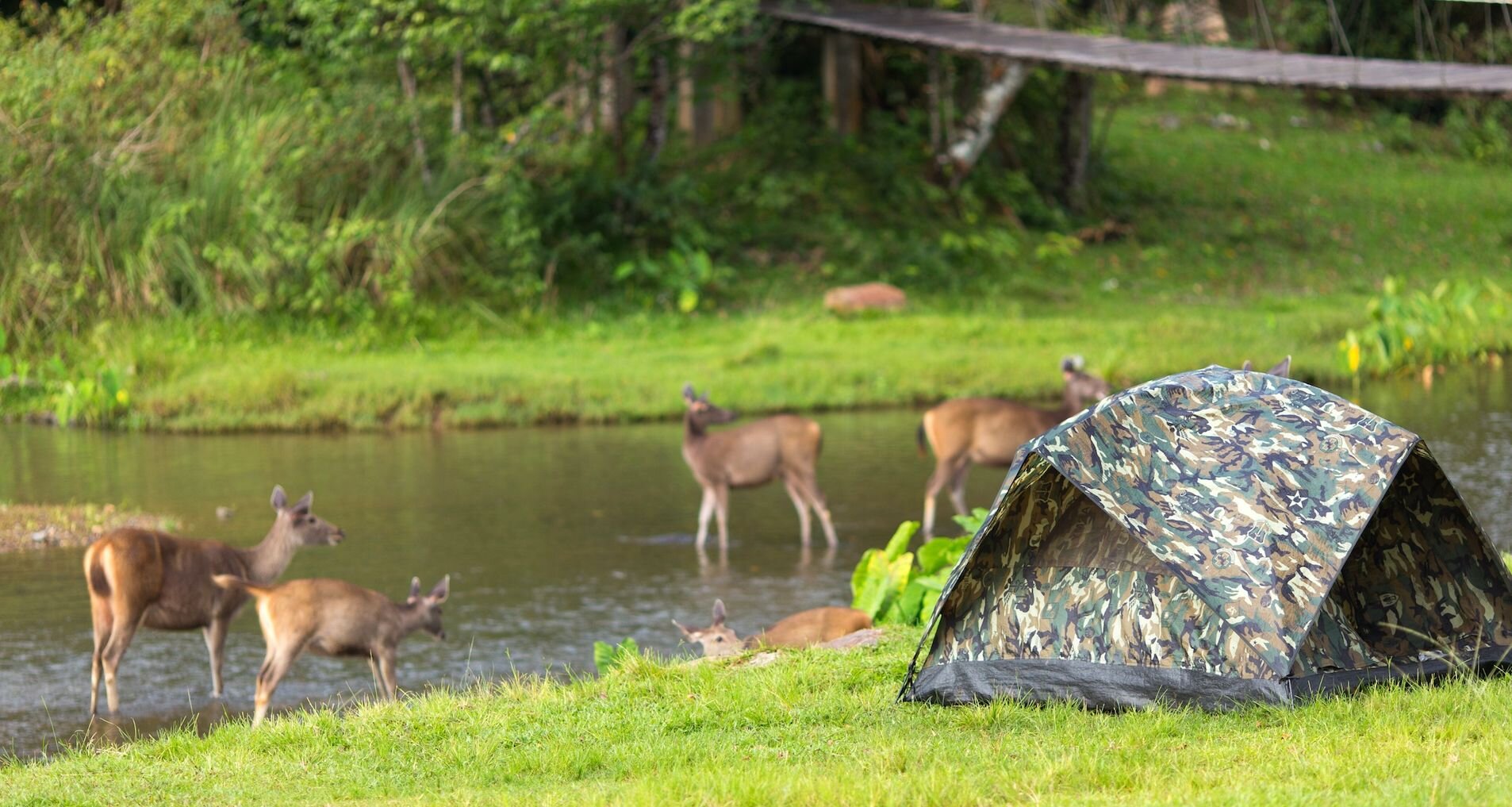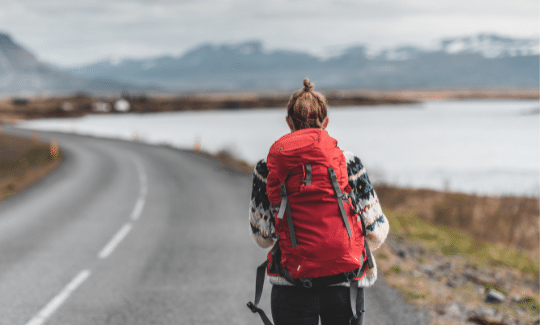A Beginner’s Guide To Wild Camping: Planning
Imagine the scenery. You are alone. Just you, a tent and a little pot bubbling on the camp stove in front of you. Nothing but wilderness and the sounds of nature around you.
At night you curl up in your sleeping bag in pitch black darkness, as you listen to the forest creaking and moving around your tent.
Wild camping is an activity in which you rely on your own skills to survive in the wild and is, in my opinion, the ultimate outdoor experience and the best way to escape from the noise and stress of daily life.
Nothing comes as close to getting you in touch with nature.
But how do you go from sitting at home and reading this article, to surviving in the wild with nothing but a tent and a sleeping bag to shield you from the outdoors?
In our very first blog series we’ll explore, step by step, all you need to know and learn to prepare for your first wild camping trip. Along with practical examples, we’ll take you all the way from the basics to the skills you’ll need to enjoy yourself while staying safe and respecting the environment around you.
With that said, let’s get started with Part 1: Planning!
While it is sometimes easy to just point at a globe and pick a random destination, wild camping requires a little more planning to go into it.
The first thing to decide is which countries are a possibility to begin with.
Wild camping is not permitted everywhere, so you’ll need to get informed on what the law is for your destination. In Europe, for example, different countries can take very different stances regarding this activity:
Some, like Norway, Sweden and Finland have a concept of “Everyman’s Right” (Right to Public Access in Finland), which declares every natural space as being public, therefore allowing complete freedom of movement. There are of course certain limitations on hunting, fishing and campfires, but wild camping itself is allowed on any stretch of land that is not privately owned.
Some countries, like France, prohibit wild camping but also tolerate it to a certain extent, depending on who you’re caught by and how close you are to urban areas. You should be ok as long as you’re nowhere near farms, towns and villages, away from paths and roads, and pack up early in the morning.
On the complete opposite side you have countries like Germany, Austria and Switzerland where wild camping is not only discouraged, it is actively punished by law. Getting caught here will certainly mean a big fine.
Get informed on what the rules are for your destination and try to stay on the right side of the law.
As annoying as it may be, remember that these rules are usually set in place for a reason, either for safeguarding private property or for the protection of natural areas.
The next step in choosing your destination is taking a look at what kind of landscape you should expect.
This is especially important when planning where you’ll be setting up camp.
For example, when I travelled to Norway and camped in the Hardangervidda National Park, the terrain proved to be of no issue when looking for a good camping spot. It was for the most part a barren moor, which left plenty of space to pitch a tent.
However, when in 2019 we visited Loch Lomond National Park in Scotland, things were a little different. Scotland allows wild camping, but with the exception of so called “camping management zones”. In this case, these zones focused on the area around the edge of the lake, meaning that the available locations where on the heavily forested hills around. This made finding a good camping spot much more difficult, as the vegetation not only limited the free space on the ground, it made getting away from the trail a real problem.
Another factor to look at is how technical the terrain is!
Make sure that you’re prepared for the physical challenges that the environment will throw at you. Be aware of the extent of the changes in elevation and how steep they are, if the trail crosses any bodies of water or if there are any dangerous obstacles you might encounter.
Finally, take into consideration the availability of water.
Whether you’ll be hiking or sticking to the same location for a few days, you’ll need to stay hydrated. Hiking and wild camping can be physically intensive activities, and dehydration can sneak up on you with little warning!
Choose your route and campsites carefully, always making sure that fresh water is available nearby. If that’s not possible, make sure you can carry a few extra litres with you.
I would recommend you take a good water filter and, if you need to, a spare reusable bottle or a hydration bladder.
It can a be a bummer to reach a destination you’ve been looking forward to visiting, only to find it covered by giant crowds.
The same applies to the outdoors, and it can ruin your experience. Nothing can take you out of experiencing wild nature quite like having to wait in line on a narrow path or seeing groups of tents clustered everywhere.
Research what the influx of visitors is like for the area you have chosen and, if possible, try to visit off season. You’ll be able to enjoy yourself more and you’ll give the environment a bit of relief as well.
Another option is to choose a more remote area, where the likelihood of meeting people is reduced. While this is ideal if you’re looking for some peace and quiet, remember to be extra careful with planning. You’ll be on your own, and will have to be able to take care of yourself with no outside help.
The number one rule of wild camping is to leave no trace. This also relates to any animals living in the area.
So, when choosing where to go, get familiar with the local wildlife. Are there any animals you could bother during important times, such as mating, nesting or birthing season? Remember that you are a guest in their home, so make sure you plan accordingly.
The same applies to any predators or dangerous wildlife that may be present in the area, so make sure that you’re well aware of what to expect and how to react in case of an encounter.
Boars, wolves and bears are just some of the many undesirable meetings one can have in the outdoors so, if necessary, learn how to best avoid them and how to behave if you end up crossing paths.
Be sure to have the knowledge to treat any possible injuries, from a simple nuisance like ticks, to more serious situations like snake bites.
Wild camping is an activity that can be done all year long, regardless of weather conditions.
With that said, the climate will of course affect what you’ll have to bring with you, like your clothes, your tent and your sleeping gear!
Because you’ll be spending several days outside, either in one location or hiking, I would recommend choosing spring, early and late summer and early autumn. The temperatures should be mild during the day and not too cold at night
Remember that temperatures are affected by multiple factors, such as local geography, altitude and wind, and not only by the seasons! It is important you do your own research first to determine what the average temperatures will be for a specific location and period of time.
The free time you have to dedicate to wild camping will of course be the first thing to consider.
When planning the length and timeline of your trip, always consider the first and last day as “non-camping”. These are the days you will be travelling to your destination and then back home.
Allocating a few extra days at the end to travel will also give your more time to reach any booked transport (train, plane, boat etc.) on time in case of delays, such as getting lost or injured.
Whether you’re hiking during the day and camping at night, or you’re setting camp in a single location over the span of a few days, you’ll have to walk to your destination.
The length of your trip will depend on the distance you’ll have to cover and on how fast you can do that, and that’s directly influenced by your fitness level, the weight you carry, the weather, the altitude and how challenging the terrain is.
As an example, I tend to usually hike very slowly to enjoy the view and the landscape. I will normally cover between 15 to 20 km (9 - 12 miles) in a day, but have managed to do a good 30 to 35 km (18 - 21 miles) when pressed.
You’ll need to determine your own speed, and the only way to do that is to practice!
Go out to the nearest park, forest or mountain, fill your backpack and take a nice day hike. You can use a hiking GPS or mobile apps such as Google Maps to measure the average distance you’ve walked over a period of time!
As you go through your planning, take note of everything you do.
Get a notebook and start writing down anything that might be useful, important or interesting: I’m talking about potential destinations, weather conditions, terrain features, points of interest, wildlife.
Anything that might affect your trip needs to be on paper!
This will not only make planning your adventure easier, it will save you time if you plan to return to the same destination in the future!
And with that, we conclude the first part of our series!
Planning is only the first step to a successful wild camping trip, and even a strong pair of legs will only get you so far.
Next time we'll be talking about the essential gear that will accompany you on your adventure, such as backpacks, camping stoves and tents!
I’ve very much enjoyed writing this article, as wild camping is without a doubt the outdoor activity that I am most passionate about!
𝘿𝙞𝙙 𝙮𝙤𝙪 𝙚𝙣𝙟𝙤𝙮 𝙩𝙝𝙞𝙨 𝙖𝙧𝙩𝙞𝙘𝙡𝙚 ?
𝘠𝘰𝘶 𝘤𝘢𝘯 𝘴𝘢𝘷𝘦 𝘰𝘳 𝘱𝘪𝘯 𝘵𝘩𝘪𝘴 𝘪𝘮𝘢𝘨𝘦 𝘴𝘰 𝘵𝘩𝘢𝘵 𝘺𝘰𝘶 𝘤𝘢𝘯 𝘢𝘭𝘸𝘢𝘺𝘴 𝘭𝘰𝘰𝘬 𝘣𝘢𝘤𝘬 𝘰𝘯 𝘵𝘩𝘦𝘴𝘦 𝘵𝘪𝘱𝘴 !
I hope that this series will spark the same interest in you, and that you’ll come back for part 2 in a few days!
I’ll see you on the trail and until then this is Luca, signing off.























If you’re tired of spending your outdoor time on a camping ground, you might want to give wild camping a shot. It’s the best way to immerse yourself in the peace and quiet of nature, just you, a tent and the wilderness around you.